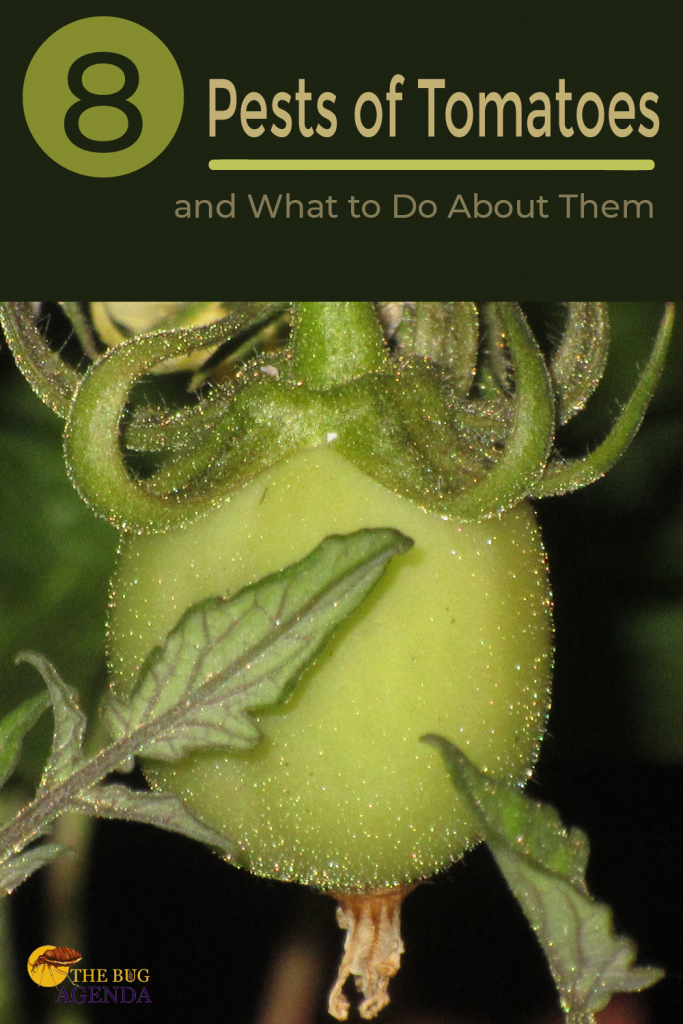Are you interested in learning about pests of tomatoes to keep your garden safe? Here are a few tomato pests to look out for.
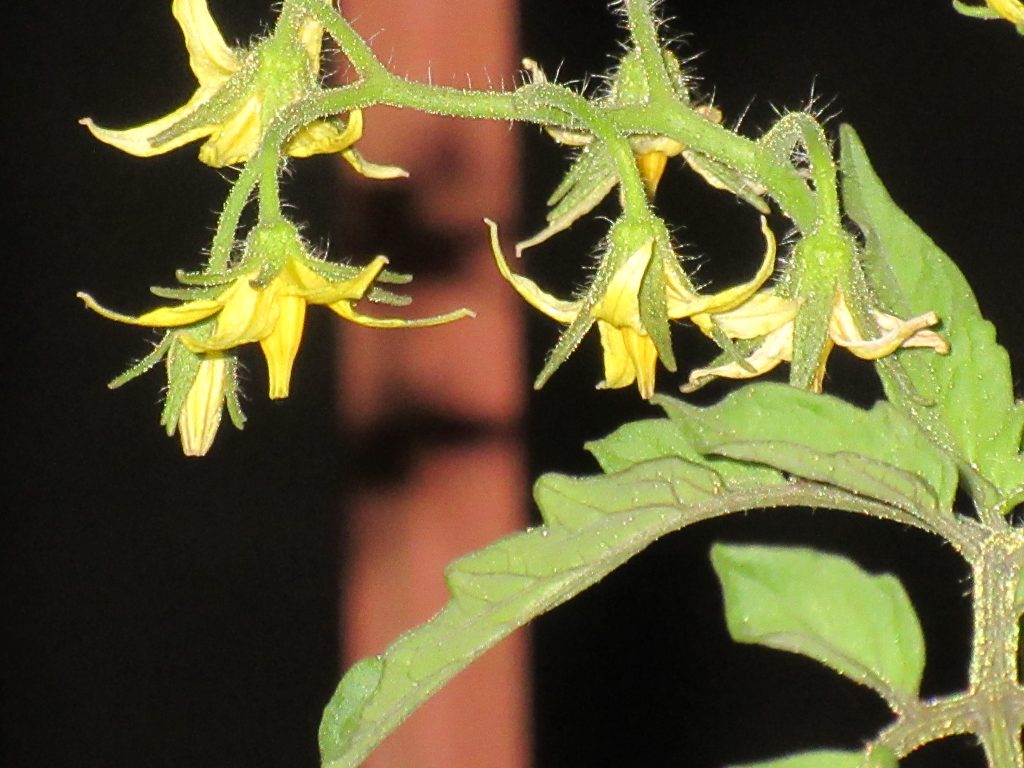
Tomatoes are beneficial crops to have at home. They contain plant chemicals called carotenoids, which support healthy eyesight and cardiovascular function.
Toss them in a bowl with veggies to create a colorful, hearty salad, or complete your sandwich with plump slices. However you wish to have your tomatoes, that’s left up to the imagination.
Tomatoes are versatile plants but will be attacked while developing. You may have seen a few insects on them. Don’t worry, a lot more pests will come as your plant grows.
However, you can patrol your tomatoes like a faithful officer of the law. You will probably not encounter all the pests of tomatoes mentioned on this list, but keep an eye out, nonetheless.
Let’s talk about 8 pests of tomatoes and simple things you can do to get rid of them.
Tomato Fruit Worm
The tomato fruit worm may be small, but this little guy is no pushover. As its name indicates, this caterpillar preys on the fruit of the plant and is one of the most (if not) destructive pests of tomatoes.
Tomato fruit worms sport a variety of colors. This includes brown, red, and green with pale yellow lines stretching lengthways. Tiny, inconspicuous spines stick out on the insect’s exterior, which is discernable when touched, as it gives off a rough feel.
Tomato plants become infected when moths deposit eggs on foliage close in proximity to the fruit. Eggs are easily identified through their white, head-like form. Before the larva emerges, eggs change from white to an almost reddish-brown hue.
Once the larva emerges, it gathers strength by snacking on leaves, before transferring to the ultimate prize—the fruit.
Tomato fruit worms prefer to attack green tomato fruits, against ripened ones. They burrow into the fruit and leave behind mush watery holes.
A single tomato fruit worm may damage various tomato fruits before completing its life cycle. There are pesticides available to discourage moths from laying eggs on the plant.
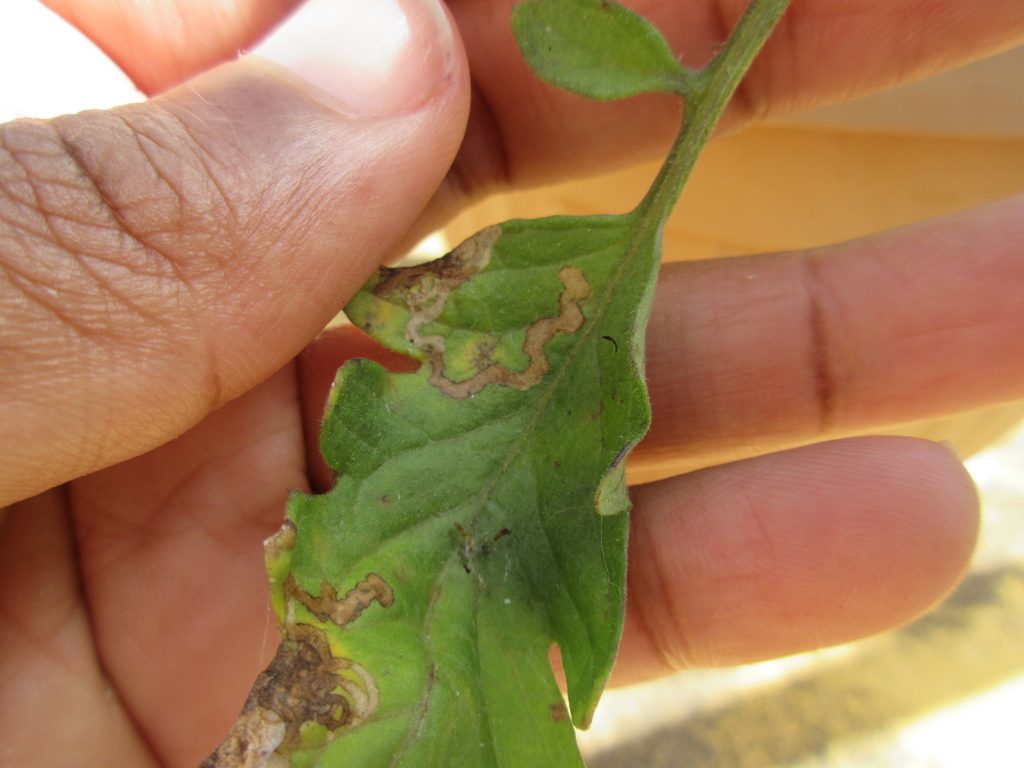
Leaf Miners
The earliest and most notable pests of tomato plants might be leaf miners. You might not see the culprit itself, but the damage inflicted.
Leaf miners affect tomato foliage and appear as scraggly lines in the plant’s leaf. The lines will be obvious, as they stick out as yellow, beige, white, or brown jagged lines and curves all over the leaves.
Once leaf miners dig deeply into the plant’s leaf, the foliage will be lost before maturity sets in.
Tomato plants become infected when adult leaf miners lay their eggs on the leaf. The larva later emerges and feeds within the leaf. Adult leaf miners include some species of flies and moths.
As soon as you spot signs of a leaf miner mining in a leaf, remove it. You may also install fine-meshed netting to prevent an adult leaf miner from laying eggs on your plants. Using a pesticide like Spinosad discourages the laying of eggs on tomatoes by adults.
Aphids
The peach and potato aphids are common sapsuckers of the tomato plant. They don’t feed on the fruit.
Aphids may be green, pink, red, or yellow in appearance. They differ in size but are distinguishable from other pests because of their soft pear-like form.
Aphids are vicious tomato pests because they transmit plant vectors. A disease of tomato might reduce plant yield or devastate the plant. If you have a large tomato farm, imagine having the entire crop infected with an aphid-carrying vector. That’s problematic for business.
Aphids on tomato plants can be tackled with vigilance. Washing tomato foliage with soapy water or even garlic spray is effective. There are also organic ways to control aphids in your garden.
Cabbage Loopers
The cabbage looper is a common pest of tomatoes, although serious damage is rare. The cabbage looper won its name for its looping motion as it travels on a plant.
Loopers prefer not to attack tomato fruits but are mere leaf feeders. A looper wears a pale-green hue, with legs at the rear and front.
In extreme infestations, cabbage loopers may steal a plant’s vitality, leaving it vulnerable to scorching from the sun. Neem oil and Spinosad can be used to prevent infestations.
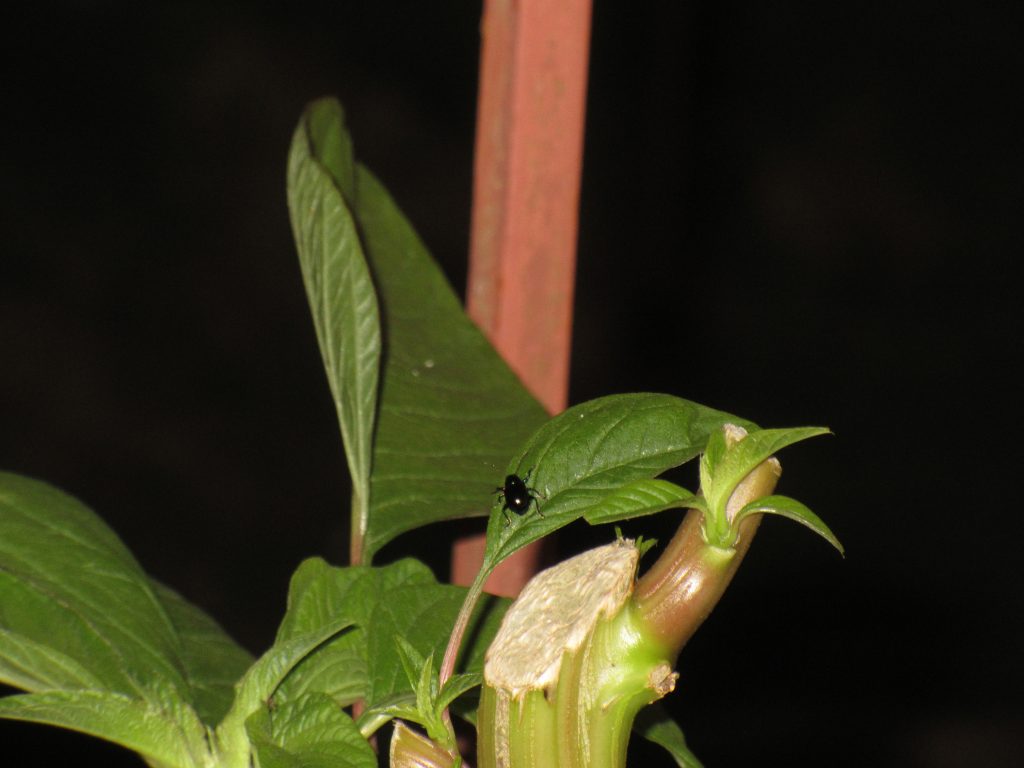
Flea Beetles
The tomato and potato flea beetles are notorious pests of tomato seedlings. As foliage feeders, they leave specks on tomato foliage. Flea beetles appear brown, black, bluish, and gray with a metallic look.
When a large onslaught occurs, an entire leaf may be destroyed. They are fierce pests of tomatoes, as they strike when the plant is a mere seedling, between 4 to 6 inches long. Large tomato plants can sustain an infestation without suffering a loss of yield.
To prevent seedlings from damage, use a physical barrier to prevent direct contact to plant foliage. A row cover or fine mesh is ideal.
*Flea beetles will at times attack tomato fruits. To learn more about beetles, check out this article.

Stink Bugs
Stink bugs are infamous for the cologne they sport. In addition to their nasty odor and abnormal shield-like form, stink bugs inflict damage on tomato plants.
Like the tomato fruit worm, the stink bug is a pest of tomato fruits. Various species of the stink bug may swarm a tomato, but the brown stink bug is a major foe.
Stink bugs have sharp mouthparts that are injected into the fruit. Once heavily infested, stink bugs could make tomato yields unsuitable for sale. When some fruits have been fed on, the area is left with light discolorations. For example, where tomato fruits are ripened, prominent yellow spots may be an indication that the area was fed upon by the pest.
To control an infestation in your garden, consider using Sevin.
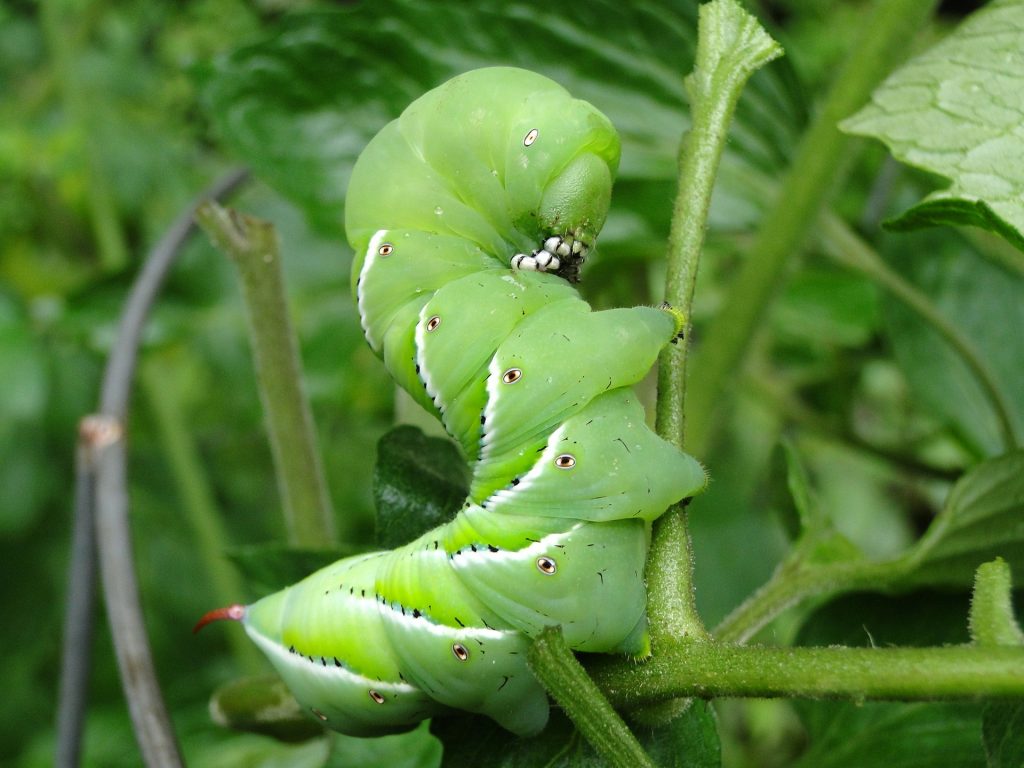
Hornworms
Hornworms are intimidating in appearance.
Your first encounter with one might be scary, depending on your tolerance for insects. These caterpillars latch on tightly to tomato plants and are often difficult to detach.
The tomato hornworm is the byproduct of the Manduca quinquemaculata or five-spotted hawkmoth and is a serious pest of tomatoes.
It’s monstrous in size and wears a green exterior. Some hornworms measure up to 4 inches and appear plump when attached to a host plant. Large worms are distinctive, with around 8 V-shaped marks on each side.
These markings appear white with black, grey, or orangish dots in the middle of each V-shape. Small tomato hornworms are often yellow or white-colored, without markings. They also wear a small horn on their last abdominal segment that sticks out (hence the name).
As voracious plant eaters, they leave behind gaps in fruits and may defoliate a tomato completely. You could have an exposed, naked tomato plant in no time if these guys are left to have their way.
Because the caterpillar camouflages with green foliage, it’s difficult to spot them at times. The larger the hornworm, the more devastating the damage. It’s not necessary to use pesticides to get rid of tomato hornworms. All you need to do is pick them off and toss them into soapy water.
Better yet, save your soap and crush them beneath your feet.
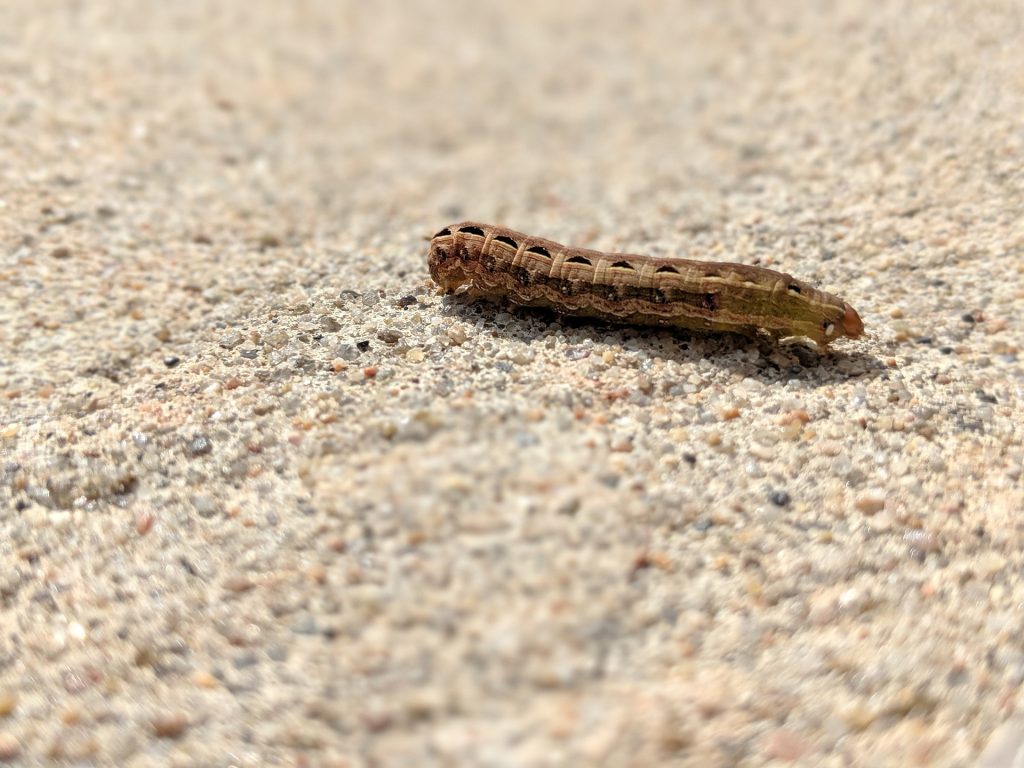
Cutworms
These caterpillars are bad and furious.
Their name says it all.
They have the uncanny habit of ‘cutting’ small or young plants as they feast. Fully developed cutworms are about two inches long. Their colors differ. You may see varieties of black, dark green, glassy, bronzed, speckled (variegated) cutworms. When agitated or disturbed, cutworms form a C-shape.
While cutworms do love your tomatoes, they will ravish peppers, carrots, cabbage, potatoes, and other crops.
So, how do cutworms ‘cut’ your tomatoes down?
They form coils around the plant’s stem as they feed. This method of feeding causes the plant to detach. While most cutworms prefer to feed on stems, the variegated cutworm has a broader terrain. It may consume buds, leaves, and fruits. Glassy cutworms stick to the roots and hidden plant parts.
The most damage is done to small plants with soft, tender tissue. Since cutworms are mainly active during evenings and nights, it’s best to monitor your tomato then, if you spot them, pick off and crush them.
You may need to use a pesticide for heavily infested zones.
These tomato pests don’t have to dampen your efforts to provide for your family. Monitor your plants every day and follow the removal tips to get rid of pests when you spot them.
Have you seen any pest of tomatoes in your garden that wasn’t discussed here? Please leave us a comment and share your experience.
We promise to update the post when necessary.
SHARE THE LOVE
If you’ve enjoyed reading this article about pests of tomatoes and found it helpful, please share.
You can pin the article on Pinterest or share it on Facebook. Any platform of your choice is fine.
Sharing our content with friends and family helps to keep the lights going so that we can continue to help you deal with simple and serious pest problems at home. As usual, we welcome any questions you may have.
Please make use of the comments section below.
